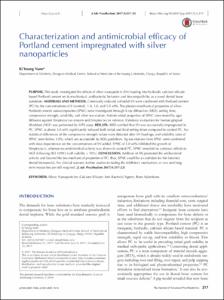Characterization and antimicrobial efficacy of Portland cement impregnated with silver nanoparticles
- Affiliated Author(s)
- 남기영
- Alternative Author(s)
- Nam, Ki Young
- Journal Title
- Journal of Advanced Prosthodontics
- ISSN
- 2005-7806
- Issued Date
- 2017
- Abstract
- PURPOSE. This study investigated the effects of silver nanoparticle (SN) loading into hydraulic calcium silicatebased
Portland cement on its mechanical, antibacterial behavior and biocompatibility as a novel dental bone
substitute. MATERIALS AND METHODS. Chemically reduced colloidal SN were combined with Portland cement
(PC) by the concentrations of 0 (control), 1.0, 3.0, and 5.0 wt%. The physico-mechanical properties of silver-
Portland cement nanocomposites (SPNC) were investigated through X-ray diffraction (XRD), setting time,
compressive strength, solubility, and silver ion elution. Antimicrobial properties of SPNC were tested by agar
diffusion against Streptococcus mutans and Streptococcus sobrinus. Cytotoxic evaluation for human gingival
fibroblast (HGF) was performed by MTS assay. RESULTS. XRD certified that SN was successfully impregnated in
PC. SPNC at above 3.0 wt% significantly reduced both initial and final setting times compared to control PC. No
statistical differences of the compressive strength values were detected after SN loadings, and solubility rates of
SPNC were below 3.0%, which are acceptable by ADA guidelines. Ag ion elutions from SPNC were confirmed
with dose-dependence on the concentrations of SN added. SPNC of 5.0 wt% inhibited the growth of
Streptococci, whereas no antimicrobial activity was shown in control PC. SPNC revealed no cytotoxic effects to
HGF following ISO 10993 (cell viability > 70%). CONCLUSION. Addition of SN promoted the antibacterial
activity and favored the bio-mechanical properties of PC; thus, SPNC could be a candidate for the futuristic
dental biomaterial. For clinical warrant, further studies including the inhibitory mechanism, in vivo and longterm
researches are still required.
- Department
- Dept. of Dentistry (치과학)
- Publisher
- School of Medicine
- Citation
- Ki Young Nam. (2017). Characterization and antimicrobial efficacy of Portland cement impregnated with silver nanoparticles. Journal of Advanced Prosthodontics, 9(3), 217–223. doi: 10.4047/jap.2017.9.3.217
Introduction
The demands for bone substitutes have markedly increased
to compensate for bone loss or to reinforce prosthodontic
dental implants. While the gold standard osseous graft is
autogenous bone graft with its excellent osteoconduction/
induction, limitations including financial cost, extra surgical
time, and additional donor site morbidity have motivated
efforts to find alternatives.1,2 Inorganic bone cements have
been used biomedically to compensate for bone defects or
as the substitutes that do not migrate from the recipient as
can occur in the granule type. Portland cement (PC) is an
inorganic, hydraulic, calcium silicate-based material. PC is
characterized by stable biocompatibility, high compressive
strength, rapid set-up, and low solubility to blood. This
allows PC to be useful in providing initial graft stability in
medical orthopedic applications.3,4 Concerning dental applications,
PC is a main component of mineral trioxide aggregate
(MTA), which is already widely used in endodontic surgery
including root end filling, root repair, and pulp capping
due to its biological and physicochemical properties.5,6 PC
stimulates mineralized tissue formation.7 It can also be economically
appropriate for use in dental bone cement for
small osseous defects.8 A pig model revealed that new bone
Corresponding author:
Ki Young Nam
Department of Dentistry, Dongsan Medical Center, School of Medicine of
Keimyung University, 56 Dalseong-ro, Jung-gu, Daegu 41931, Republic
of Korea
Tel. +82532507807: e-mail, nkyp@dsmc.or.kr
Received January 12, 2017 / Last Revision June 8, 2017 / Accepted June
12, 2017
© 2017 The Korean Academy of Prosthodontics
This is an Open Access article distributed under the terms of the Creative
Commons Attribution Non-Commercial License (http://creativecommons.
org/licenses/by-nc/3.0) which permits unrestricted non-commercial use,
distribution, and reproduction in any medium, provided the original
work is properly cited.
pISSN 2005-
- Type
- Article
- ISSN
- 2005-7806
- Appears in Collections:
- 1. School of Medicine (의과대학) > Dept. of Dentistry (치과학)
- 파일 목록
-
-
Download
 oak-2017-0174.pdf
기타 데이터 / 827.36 kB / Adobe PDF
oak-2017-0174.pdf
기타 데이터 / 827.36 kB / Adobe PDF
-
Items in Repository are protected by copyright, with all rights reserved, unless otherwise indicated.